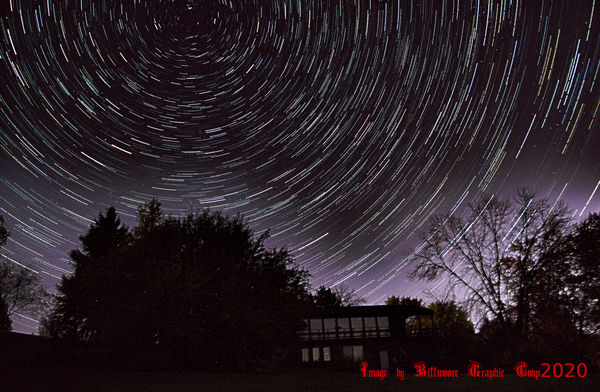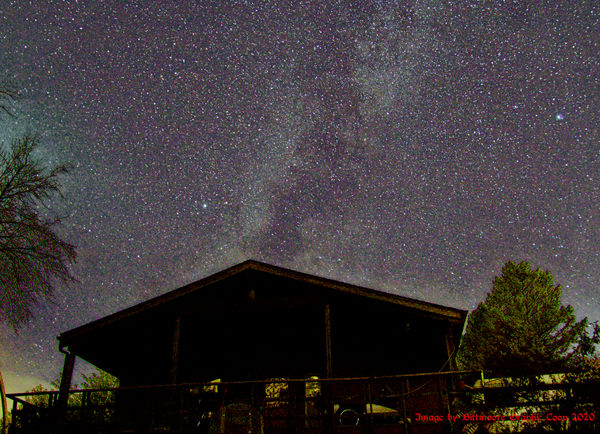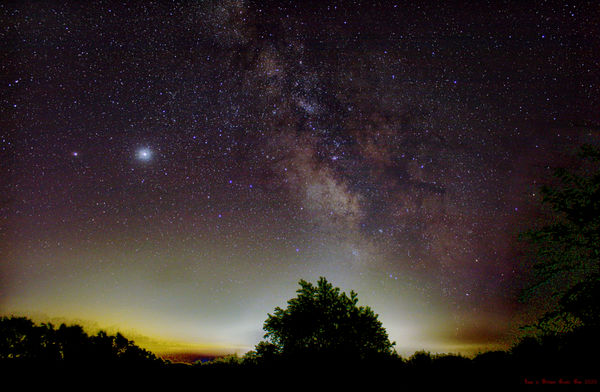Anyone using SiriL?
Nov 30, 2020 11:39:08 #
Bittmoore
Loc: SE Wisconsin
Except for one or two nights this last week it's been overcast here for quite a long time so I've continued to check out other software for processing my captures.
Still using DSS majority of the time for the majority of my sessions. Found a few where I preferred Sequator's output.
Recently I started checking out SiriL (IRIS for Linux) for Windows as I never got far trying IRIS and its command line.
Tried searching here but came up with no topics on SiriL so I'm wondering if anyone here has used it and any hints, tips, secrets, ...?
Still using DSS majority of the time for the majority of my sessions. Found a few where I preferred Sequator's output.
Recently I started checking out SiriL (IRIS for Linux) for Windows as I never got far trying IRIS and its command line.
Tried searching here but came up with no topics on SiriL so I'm wondering if anyone here has used it and any hints, tips, secrets, ...?
Nov 30, 2020 12:27:24 #
Ballard
Loc: Grass Valley, California
Bittmoore wrote:
Except for one or two nights this last week it's b... (show quote)
Never tried it, but I switched over from DSS to pixinsight for stacking deep sky images as it has a lot of tools built in for working on deep sky stuff. I even use it to help clean up some planetary images, but use PIPP followed by AutoStakkert for the initial stacking of the planetary images. Pixinsight does cost a bit and does have a steeper learning curve than DDS but has some great features. Would love to hear how well SiriL does work out however.
Nov 30, 2020 12:38:29 #
Bittmoore
Loc: SE Wisconsin
As $$ is nearly as hard to come by as clear skies and good seeing I'm trying out a lot of software starting with free/low cost and working my way up to the steep $$/learning curve offerings.
One thing I've found I'm not overjoyed about is the number files it creates during processing. Starting by converting CR2 (18MB) -> FIT (35MB) and each following step creates a new FIT file none of which are auto deleted, or reused, when moving to the next step in the process.
I'll post an image once I get time to work a set all the way through.
One thing I've found I'm not overjoyed about is the number files it creates during processing. Starting by converting CR2 (18MB) -> FIT (35MB) and each following step creates a new FIT file none of which are auto deleted, or reused, when moving to the next step in the process.
I'll post an image once I get time to work a set all the way through.
Dec 1, 2020 13:38:29 #
Ballard
Loc: Grass Valley, California
Bittmoore wrote:
As $$ is nearly as hard to come by as clear skies ... (show quote)
Hi Bittmoore
Using the free stuff is a good way to start, that is what I did. Most of the stuff I currently use except for Pixinsight (and a few others) was free. This includes, Registax6 (only 32 bit program so limited in the size of video files it will handle), Autostakkert for planets, PIPP (Planetary imaging preprocessor) also for planets, winJPOS (for derotating planetary images). For telescope guiding I use the freeware program PHD (PHD also has some nice polar alignment tools) and for DSLR camera control I use the EOS program that came with the camera , for my mono planetary camera I use the freeware program FireCapture (This is a Java program so you also need to Load Java which is free). I also use some generic photo editors including RawTherapee (freeware), Canon Digitial Photo Professional (came with my canon DSLR) and an old copy of Picture window that I purchased a number of years ago (there is a completely new version available but I would have to buy it). I also did buy a copy of TheSky X which is a great program for figuring out what I what to look at and also ties into my telescopes mounts so that I can point and click where I want the telescope to go. I use windows 10 pro on both my desktop and laptop which allows me to connect the laptop to the telescope and then remote the interface from my laptop to the desktop to control everything away from mosquitoes in the summer and cold in the winter. Note: For several of the programs you also need to load in the ASCOM platform which is also free. This includes The sky X for telescope control, PHD and Firecapture.
Most programs do keep a number of files around so that you can go back and reprocess from different points in the process, I do normally go back and remove them once I'm satisfied with the final image to save disc space. To make this easy I tell the programs where I want them to store the files so I can just get rid of whole directories when I'm done. For all the programs I use, I keep the images in tif format since everything knows how to access tif. (Pixinsight does have intermediate image files that are 32bit and 64bits wide to maintain the maximum dynamic range of the of the stacked images, I do keep, flats, darks, and Bias master files in this format for reuse).
The biggest expense for me has been the hardware including the telescopes, mounts and the computer hardware that I upgraded to a 16 core 3.5 gig processor with 64 gig of ram to help with image processing (pixinsight will use it all).
Below are links to a photo of the North American Nebula that I processed with DSS and then went back using the same data and reprocessed with Pixinsight. These where taken with my canon DLSR using a canon telephoto lens that with piggybacked on a refractor mounted on a Losmandy G11 telescope mount.
Original using DSS
https://www.uglyhedgehog.com/t-599872-1.html
Reprocessed with pixinsight
https://www.uglyhedgehog.com/t-620263-1.html
Dec 2, 2020 16:50:49 #
Bittmoore
Loc: SE Wisconsin
Ballard wrote:
Hi Bittmoore br Using the free stuff is a good way... (show quote)
Very nice images!
I have a number of those software (PIPP,Registax6, Autostakkert, RawTherapee) - as well as darktable - although I haven't delved much into them. Trying to learn one, maybe two, at a time. I'm easy enough to confuse.
I understand about reprocessing as I've gone back and redone things as I learn a new technique or get "substantially" better. I archive the CR2s. I'm talking about the temporary files. In SiriL this means converting the CR2 files (~19MB each) -> TIFF (~35MB each); those files then go to preprocessing (creates whole new files ~35MB each) then stacking (more new files) then debayering (more new files ~105MB each) to registration (even more new files ~105MB each) to output. I have set up folders (lights, darks, bias; I've never taken flats and don't really get "dark flats" as a concept) for SiriL to work in but that's still a lot of working space required.
As I'm using a Canon Rebel T4i and a T6 I have EOS and DPP. I've looked at using EOS but the fact that USB cable lengths say to keep it less than 15', and preferably around 10' or less is better - and the minimum time between images - I haven't done much with it. Also, it only handles one camera and when possible I like to run both on different targets.I'm looking at backyardEOS but am satisfied with my remote shutter release for now. When I get a tracking mount that'll probably change. I'm sure I can get more out of my data once I know how to use the tools.
Image 1: A short stack (15, maybe 20 subs) from a target planning session this past Oct. South end of my lot looking North. PP using Sequator -> GIMP (new to using GIMP for astrophotography so still feeling my way around).
Image 2: Another short stack from a planning session around the same time but in the driveway facing west. Iirc there are about 50 subs. Another Sequator -> GIMP PP.
Image 3: Taken from the deck (visible in #1) facing south this past July. Iirc 125 subs run through Sequator -> GIMP for PP. Clearly would have been much better from the ground but I wouldn't have survived the mosquitoes while setting up. At least on the deck the bats helped some. Once I was set up. 😉
1). Canon T6; Tamron 18-400mm @ 18mm, f/4, 15sec; ISO 1600

(Download)
2). Canon T6; Tamron 18-400mm @ 18mm, f/4, 15 sec; ISO 1600

(Download)
3). Canon T6; Canon 18-55mm kit lens @ 18mm, f/4, 5sec; ISO 1600

(Download)
Dec 3, 2020 12:38:09 #
Ballard
Loc: Grass Valley, California
Hi Bittmoore
Those star shots came out great.
I never have used Dark Flats either, However I have found that regular flats help with any vingetting in the field of view and do remove any dust donuts that get in the image. I normally only keep the initial data (CR2s, .mov, .ser) and the final images and purge the rest. It can still be a lot of space however, for some of the planetary video it can be 15 gig per image. I've been thinking of getting a NAS server with RAID 5 capability to store all the image data (including regular photography). Currently every few months I copy everything to a couple of sets of backup discs, one I store locally and the other in a friends safe. I have noticed that the price point for storage is now optimal at around the 8 terabytes per drive, I expect I will be upgrading some of my older drives with that size in the future. The USB cable limit does pose an issue (particularly with high speed USB 3), to get around this I leave the laptop by the telescope when imaging and then remote the interface over gigE to my desktop inside to avoid the mosquitoes. I do like the EOS interface on the computer since I can magnify the image for focusing the canon DSLR, and I haven't tried using multiple cameras at the same time.
Those star shots came out great.
I never have used Dark Flats either, However I have found that regular flats help with any vingetting in the field of view and do remove any dust donuts that get in the image. I normally only keep the initial data (CR2s, .mov, .ser) and the final images and purge the rest. It can still be a lot of space however, for some of the planetary video it can be 15 gig per image. I've been thinking of getting a NAS server with RAID 5 capability to store all the image data (including regular photography). Currently every few months I copy everything to a couple of sets of backup discs, one I store locally and the other in a friends safe. I have noticed that the price point for storage is now optimal at around the 8 terabytes per drive, I expect I will be upgrading some of my older drives with that size in the future. The USB cable limit does pose an issue (particularly with high speed USB 3), to get around this I leave the laptop by the telescope when imaging and then remote the interface over gigE to my desktop inside to avoid the mosquitoes. I do like the EOS interface on the computer since I can magnify the image for focusing the canon DSLR, and I haven't tried using multiple cameras at the same time.
If you want to reply, then register here. Registration is free and your account is created instantly, so you can post right away.